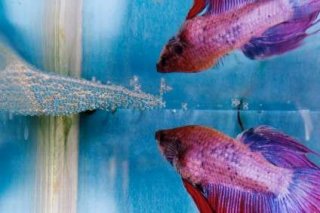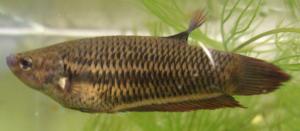
 Custom Search
Custom Search
Breeding Betta splendens can be quite a rewarding experience. You can easily tell the difference between male and female bettas because the male is more colorful and has larger fins. Although generally less colorful, female bettas do come in a variety of colors.
It is best to have your betta pair in a separate breeding tank. To condition the pair for breeding it is best to raise the water temperature in the tank to about 80 degrees Fahrenheit or about 27 degrees Celsius.
Feeding the pair live foods will facilitate breeding. Frozen foods will also work, especially frozen mysis shrimp or brine shrimp, and are generally easier than giving the pair live food.
Female Betta Splendens - by HAH
Betta Spawning Tank Set-Up
To breed your bettas the first thing you should do is have a breeding tank set up. A 6-10 gallon aquarium will do. Don't add substrate to the bottom of the tank, otherwise the male will have trouble retrieving the eggs.
You don't want a power filter that will suck in the fry. A sponge filter is best.
You will need to provide lots of floating plants and a cave for the female to hide from the male. Betta spawning can become quite violent.
 Adding Your Bettas to the Spawning Tank
Adding Your Bettas to the Spawning Tank
After your betta spawning tank is set up, you need to add the fish. First place the male into the tank. You will need a see through aquarium divider for the tank. Then add the female betta onto the other side of the divider so that the male and female betta can see one another, but can't make contact. If you place a male and female betta together before the female is ready to spawn he will kill her.
If you don't have an aquarium divider for your tank you can use a breeding net or breeding trap made for livebearers, but keep in mind that your female betta won't be very happy in such a small space. It generally takes 5-7 days before she will be ready to spawn.
You can tell when your male betta is ready to spawn because he will build a bubblenest as seen in the above photo. You can tell when a female betta is ready to breed because her abdomen will be slightly swollen with eggs and you will also see an ovipositor in her anal area. The ovipositor is a very small, short, white tube. She will also develop vertical (not horizontal) stripes or bars on her body.
It is important to give the female betta hiding places in the breeding tank in case the male becomes overly aggressive. If you place a female betta that is not ready or is unwilling to breed in the breeding tank with a male betta he may kill her. Providing plants and other hiding places in the tank will help to prevent this.
After the bubblenest is ready, the male betta will go in search of the female. Providing that all goes well and she is willing and ready to breed, then the pair will embrace directly under the bubblenest. During this embrace the eggs are squeezed out of the female betta and sperm is released.
The eggs will fall to the bottom of the tank and the male will retrieve them with his mouth and then place them into the bubblenest.
Once spawning is over the female betta should be removed from the tank for her safety and also the safety of the eggs. The male betta will attack the female after spawning is over and female bettas will eat the eggs. Leave the male betta in the tank with the eggs. He will stand guard and tend to the eggs in the bubblenest until they hatch about 48 hours later.
Care of Betta Fry
Once the eggs hatch, most of them will still have their yolk sacs attached. The male betta should be removed once the fry become free-swimming or he may eat them.
Feed the fry once they are free-swimming. Commercial preparations of liquid fry food for egglaying fish are available. Fry may also be fed infusoria or mashed up hard-boiled egg yolk mixed with water or squeezed through a cloth. When the betta fry are older (about a week after they are free-swimming) feed them newly hatched brine shrimp.









